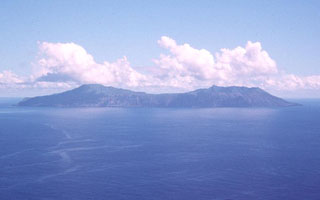Report on Anatahan (United States) — August 2004
Bulletin of the Global Volcanism Network, vol. 29, no. 8 (August 2004)
Managing Editor: Richard Wunderman.
Anatahan (United States) Explosions and ash plumes end in early August
Please cite this report as:
Global Volcanism Program, 2004. Report on Anatahan (United States) (Wunderman, R., ed.). Bulletin of the Global Volcanism Network, 29:8. Smithsonian Institution. https://doi.org/10.5479/si.GVP.BGVN200408-284200
Anatahan
United States
16.35°N, 145.67°E; summit elev. 790 m
All times are local (unless otherwise noted)
The current eruption began after increased seismicity on 31 March 2004 (BGVN 29:04 and 29:05). Lava was noted in the crater on [12] April and may have extruded for a few weeks thereafter. The most energetic phase occurred during 24-28 April, when a ash clouds rose ~ 1,000 m. This report summarizes activity from mid-June through September 2004.
During June, seismicity was higher as a result of more frequent small explosions every few tens of seconds, and a 100-km-long, light-colored plume of steam and ash was occasionally visible. A cone active since at least 10 June produced continuous Strombolian explosions that ejected material as high as 100 m every few tens of seconds to minutes, filling the inner crater by about 10 July. The seismicity level was generally significantly lower during 14-16 June, after which it returned to earlier levels. On 27 June a tropical storm knocked out the last seismic station on the island.
The last time the weather was clear enough to see well, on 3 July, the Washington VAAC reported a 31-km-long ash plume well below 3 km altitude. During a few days in mid-July, prolonged periods, 10-15 minutes long, of continuous ash emission began to occur and became more frequent. A plume of light ash and steam trailed tens of kilometers WSW at altitudes less than 3 km.
Seismicity increased on 23 July to approximately double the level of the previous day, approaching the previous high of late April. The seismic signals indicated somewhat larger and longer periods of ash emission. Strombolian explosions continued to occur very frequently. The explosions threw mostly coarse material upward a hundred meters or so at intervals of tens of seconds to a few minutes. A plume of light ash and steam trailed a few tens of kilometers downwind, generally W, at altitudes below 1.8 km. An Air Force Weather Advisory on 24 July reported that their satellite could see the source as a hot spot. The Commonwealth of the Northern Mariana Islands Emergency Management Office (CNMI/EMO) reported a plume of light ash trailing a few tens of kilometers WSW at altitudes below ~ 3 km.
Joe Kaipat (EMO) visited the island on 25 July with personnel from Fish and Wildlife and reported observing an ash plume probably a few tens of kilometers long moving NE. This plume persisted until 3 August, less than a few kilometers long and below 600 m. After 26 July seismicity decreased to a very low level, with the signals indicating that the frequent individual explosions of several days before had decreased significantly in size and number and finally ceased by 31 July. Instead, ash and gas were being ejected almost continuously. Seismicity remained very low and frequent individual explosions ceased through August and September 2004.
Geological Summary. The elongate, 9-km-long island of Anatahan in the central Mariana Islands consists of a large stratovolcano with a 2.3 x 5 km compound summit caldera. The larger western portion of the caldera is 2.3 x 3 km wide, and its western rim forms the island's high point. Ponded lava flows overlain by pyroclastic deposits fill the floor of the western caldera, whose SW side is cut by a fresh-looking smaller crater. The 2-km-wide eastern portion of the caldera contained a steep-walled inner crater whose floor prior to the 2003 eruption was only 68 m above sea level. A submarine cone, named NE Anatahan, rises to within 460 m of the sea surface on the NE flank, and numerous other submarine vents are found on the NE-to-SE flanks. Sparseness of vegetation on the most recent lava flows had indicated that they were of Holocene age, but the first historical eruption did not occur until May 2003, when a large explosive eruption took place forming a new crater inside the eastern caldera.
Information Contacts: Juan Takai Camacho and Ramon Chong, CNMI/EMO, Saipan, MP 96950, USA (URL: http://www.cnmihsem.gov.mp/); Frank Trusdell, U.S. Geological Survey, Hawaiian Volcano Observatory (HVO), PO Box 51, Hawaii National Park, HI 96718, USA (URL: https://volcanoes.usgs.gov/nmi/activity/); Washington Volcanic Ash Advisory Center (VAAC), Satellite Analysis Branch, NOAA/NESDIS E/SP23, NOAA Science Center Room 401, 5200 Auth Road, Camp Springs, MD 20746, USA (URL: http://www.ssd.noaa.gov/).

